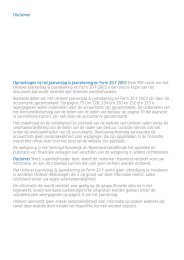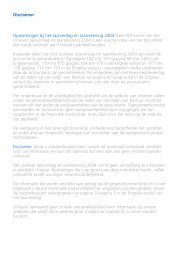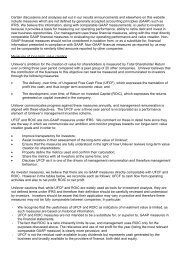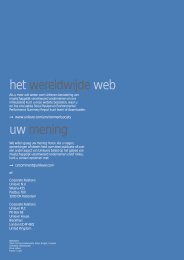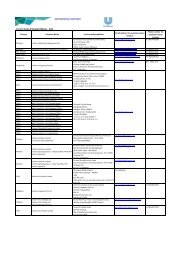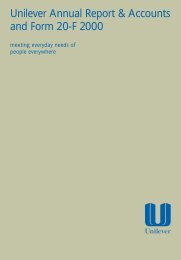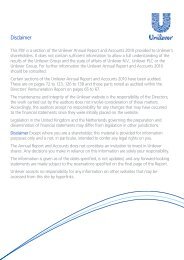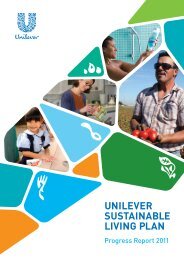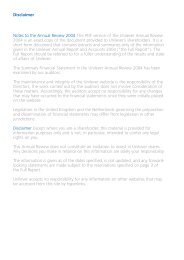Meeting everyday needs of people everywhere - Unilever
Meeting everyday needs of people everywhere - Unilever
Meeting everyday needs of people everywhere - Unilever
You also want an ePaper? Increase the reach of your titles
YUMPU automatically turns print PDFs into web optimized ePapers that Google loves.
Control <strong>of</strong> <strong>Unilever</strong><br />
NV’s issued share capital on 31 December 1999 was made<br />
up <strong>of</strong>:<br />
•<br />
•<br />
•<br />
Fl. 640 165 008 split into 571 575 900 ordinary shares<br />
<strong>of</strong> Fl. 1.12 each.<br />
Fl. 2 400 000 split into 2400 ordinary shares<br />
numbered 1 to 2400, known as special shares.<br />
Fl. 286 207 379 split into several classes <strong>of</strong> cumulative<br />
preference shares.<br />
Shareholders <strong>of</strong> NV have one vote for every ten cents<br />
(Fl. 0.10) <strong>of</strong> capital they own, <strong>of</strong> whatever type. An<br />
exception is that half <strong>of</strong> the special shares are owned by<br />
Naamlooze Vennootschap Elma, which is not allowed to<br />
vote at general NV shareholders’ meetings because it is<br />
a subsidiary <strong>of</strong> NV.<br />
PLC’s issued share capital on 31 December 1999 was<br />
made up <strong>of</strong>:<br />
•<br />
•<br />
£40 760 420 split into 2 911 458 580 ordinary shares<br />
<strong>of</strong> 1.4p each.<br />
£100 000 <strong>of</strong> deferred stock.<br />
Shareholders <strong>of</strong> PLC have one vote for every 1.4p <strong>of</strong><br />
capital they own, <strong>of</strong> whichever type. An exception is that<br />
half <strong>of</strong> the deferred stock is owned by United Holdings<br />
Limited, which is not allowed to vote at general PLC<br />
shareholders’ meetings because it is a subsidiary <strong>of</strong> PLC.<br />
Unity <strong>of</strong> management<br />
In order to ensure unity <strong>of</strong> management, NV and PLC<br />
have the same directors. We achieve this through our<br />
nomination procedure. Only the holders <strong>of</strong> NV’s special<br />
shares can nominate anyone for election to the NV board,<br />
and only the holders <strong>of</strong> PLC’s deferred stock can nominate<br />
anyone for election to the PLC board. The current<br />
directors can ensure that both NV and PLC shareholders<br />
are presented with the same candidates for election as<br />
directors, because the joint holders <strong>of</strong> both the special<br />
shares and the deferred stock are NV Elma and United<br />
Holdings Limited, which are subsidiaries <strong>of</strong> NV and PLC.<br />
NV and PLC both act as directors <strong>of</strong> NV Elma and <strong>of</strong><br />
United Holdings Limited. The Chairmen <strong>of</strong> NV and PLC<br />
are additional directors <strong>of</strong> United Holdings Limited.<br />
Equalisation Agreement<br />
In order that NV and PLC operate for all practical purposes<br />
as a single company, we have an Equalisation Agreement.<br />
Under the Equalisation Agreement NV and PLC adopt the<br />
same financial periods and accounting policies. Neither<br />
company can issue or reduce capital without the consent<br />
<strong>of</strong> the other. If one had losses, or was unable to pay its<br />
preference dividends, we would make up the loss or<br />
shortfall out <strong>of</strong>:<br />
•<br />
•<br />
•<br />
the current pr<strong>of</strong>its <strong>of</strong> the other company (after it has<br />
paid its own preference shareholders).<br />
then its own free reserves.<br />
then the free reserves <strong>of</strong> the other company.<br />
If either company could not pay its ordinary dividends we<br />
would follow the same procedure, except that the current<br />
pr<strong>of</strong>its <strong>of</strong> the other company would only be used after it<br />
had paid its own ordinary shareholders and if the directors<br />
thought it appropriate.<br />
So far NV and PLC have always been able to pay their own<br />
dividends, so we have never had to follow this pro c e d u re .<br />
I f we did, the payment from one company to the other<br />
would be subject to any United Kingdom and Dutch tax<br />
and exchange control laws applicable at that time.<br />
The Equalisation Agreement also makes the position <strong>of</strong><br />
the shareholders <strong>of</strong> both companies, as far as possible,<br />
the same as if they held shares in a single company. To<br />
make this possible we compare the ordinary share capital<br />
<strong>of</strong> the two companies in units: a unit made up <strong>of</strong> Fl. 12<br />
nominal <strong>of</strong> NV’s ordinary capital carries the same weight<br />
as a unit made up <strong>of</strong> £1 nominal <strong>of</strong> PLC’s ordinary capital.<br />
For every unit (Fl. 12) you have <strong>of</strong> NV you have the same<br />
rights and benefits as the owner <strong>of</strong> a unit (£1) <strong>of</strong> PLC.<br />
NV’s ordinary shares currently each have a nominal value<br />
<strong>of</strong> Fl. 1.12, and PLC’s share capital is divided into ordinary<br />
shares <strong>of</strong> 1.4p each. This means that a Fl. 12 unit <strong>of</strong> NV is<br />
made up <strong>of</strong> 10.71 NV ordinary shares <strong>of</strong> Fl. 1.12 each and<br />
a £1 unit <strong>of</strong> PLC is made up <strong>of</strong> 71.43 PLC ordinary shares<br />
<strong>of</strong> 1.4p each. Consequently, one NV ordinary share<br />
equates to 6.67 ordinary shares <strong>of</strong> PLC.<br />
When we pay ordinary dividends we use this formula.<br />
On the same day NV and PLC allocate funds for the<br />
dividend from their parts <strong>of</strong> our current pr<strong>of</strong>its and free<br />
reserves. We pay the same amount on each NV share as<br />
on 6.67 PLC shares calculated at the relevant exchange<br />
rate: for interim dividends this exchange rate is the<br />
average rate for the quarter before we declare the<br />
dividend. For final dividends it is the average rate for the<br />
year. In arriving at the equalised amount we include any<br />
tax payable by the company in respect <strong>of</strong> the dividend,<br />
but calculate it before any tax deductible by the company<br />
from the dividend.<br />
In principle, issues <strong>of</strong> bonus shares and rights <strong>of</strong>ferings<br />
can only be made in ordinary shares. Again we would



